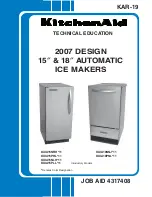
4
POSITIONING
The pasta cooker must be no closer than 6" from any
combustible material. When placed under an exhaust
hood with a fire retardant system it must comply with
ANSI/UL 507-(Latest Edition) and ANSI/NFPA 96-
(Latest Edition). No frame or restriction can be
constructed around the lower part of the pasta cooker
that would restrict ventilation or air movement into the
pasta cooker. You must insure adequate air supply to
the pasta cooker.
Adequate clearance for servicing and proper operation
must be maintained. Your pasta cooker is designed to
be serviced from the front. Do not place a pasta cooker
next to a deep fat fryer. Hot oil and water can cause an
unstable condition creating a hazardous situation. The
pasta cooker will operate at highest efficiency when
properly leveled. Place a level across the cooker front
panel from left to right, and then front to rear. Screw the
adjustable bullet feet or casters in or out as necessary
until the cooker is as level as possible. Each leg is
adjustable to
3
/
4
". Do not expose more than three
threads on the stem of the caster.
LEVELING
The Pasta System will operate at its highest efficiency
when properly leveled. Place a level on Pasta System
vessel from side to side. For Pasta Systems on legs, the
bottom foot of the leg is adjustable. Turn counter
clockwise to decrease height or clockwise to increase
height until level. For Pasta Systems on casters, the
casters are adjustable by loosening the jam nut and
turning the caster in or out. When the desired level is
reached, tighten the jam nut. Adjustments of more than
3
/
4
" are not recommended on any caster. The same
procedure should be followed to level the Pasta System
from front to back.
Figure 2-1
RESTRAINING
DEVICES
On Custom Pasta
™
System
installations with casters, casters and
jam nuts must be completely
tightened. Adequate means must also
be provided to limit the movement of
the appliance without depending on
the connector, the quick-disconnect
device or its associated piping to limit
the appliance movement.
Connectors must comply with ANSI Z21.69/CAN1
CAN/CGA 6.16 (latest edition) for connectors for
movable gas appliances. Quick-disconnect devices
must comply with ANSI Z21.41/CAN 1 6.9 (or latest
edition) standard for quick-disconnect devices for use
with gas fuel as applicable.
IF DISCONNECTION OF THE RESTRAINT IS
NECESSARY, IT MUST BE RECONNECTED WHEN
THE CUSTOM PASTA
™
SYSTEM IS RETURNED TO
ITS ORIGINALLY INSTALLED POSITION.
ELECTRICAL CONNECTION
Your pasta cooker has been ordered in either 1 phase
or 3 phase by your dealer. All electrical connections
should be made by a licensed electrician. If necessary
this unit can be field changed from 1 phase to 3 phase
or from 3 phase to 1 phase. Have a qualified electrician
refer to the wire diagram.
ALL ELECTRICAL WIRING LEADING TO THE PASTA
COOKER MUST CONFORM TO LOCAL CODES. BE
SURE THE ON/OFF SWITCH IS IN THE OFF
POSITION BEFORE TURNING THE POWER ON TO
THE PASTA COOKER.
WATER AND DRAIN CONNECTION
The water is to be connected to the
3
/
8
" female pipe
connection on the cabinet back, for auto-fill and the
optional faucet.
Make sure this and all other connections do not leak.
Check your water pressure. The auto-fill system is not
designed to handle pressure greater than 60 psi. Any
pressure greater than this can damage the auto-fill
solenoid or cause the system to fail. If the pressure is
greater than 60 psi a pressure regulator should be
added. The water temperature must not exceed 150°F
(65.6°C). Hot or warm water is not needed due to the
instant recovery of the Custom Pasta
™
System.
If during operation the boil is killed when water
automatically enters the pasta cooker, turn the water
pressure down until the water is added without killing
the boil. The drain terminates within inches of the floor
and is designed for the standard dump to drain opening.
WARNING
Restraining devices
required.
CLEARANCES
Combustible
Construction
Non-Combustible
Construction
Back
6"
0"
Right Side
6"
0"
Left Side
6"
0"
Caster
Summary of Contents for 240V
Page 18: ...16 VIII WIRING DIAGRAMS 14 ELECTRIC PASTA 2 THERMOSTAT WIRING DIAGRAM WITHOUT TIMERS...
Page 19: ...17 14 ELECTRIC PASTA WITH 138 TIMERS WIRING DIAGRAM...
Page 20: ...18 18 20 ELECTRIC PASTA WITH 138 TIMERS WIRING DIAGRAM...
Page 21: ...19 18 ELECTRIC PASTA 2 THERMOSTAT WIRING DIAGRAM WITHOUT TIMERS...







































